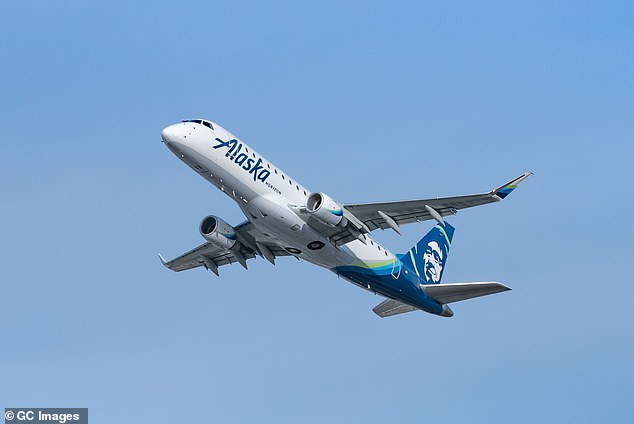A Horizon Air flight was forced to return to an Alaska airport on Christmas Eve, after the plane struck an eagle – just days after another bird strike in South Korea left 179 people dead.
Alaska Airlines officials, which owns Horizon Air, told NBC News Horizon Air Flight 2041 took off at noon on December 24 and soon ‘the crew reported a bird strike.’
The flight to Fairbanks then turned around, and arrived back at Ted Stevens International Airport in Anchorage about half an hour later.
‘The captain and first officer are trained for these situations and landed the aircraft safely without any issue,’ a spokesperson for the airline noted.
‘No emergency was declared.’
Passengers were then put on another aircraft at the airport to continue their trip to Fairbanks, as the plane was removed from service for inspection.
It has since returned to service, according to NBC News.
‘[It’s a] Christmas Eve story,’ passenger Michelle Tatela told KTUU in the aftermath. ‘We’re like, “Only in Alaska do you have to wait for a new plane, cause there was an eagle flying with you.”‘

Horizon Air Flight 2041 was forced to return to an airport in Anchorage, Alaska on Christmas Eve after it struck an eagle. The airline is owned and operated by Alaska Airlines

It returned to the Ted Stevens International Airport in Anchorage just about half an hour after it took off
She recounted how they were only in the air for a few minutes, when the captain said they were turning back ‘out of an abundance of caution.’
It was only after the plane landed that the passengers learned the plane struck an eagle – the same day President Joe Biden signed a law establishing the bald eagle as the official bird of the United States.
‘The eagle survived at that time,’ said Tatela, whose mother and sister were visiting from Chicago. ‘And there were a bunch of police cars around the plane.’
She said that it would have been ‘a scarier situation’ to see all the emergency vehicles if she had not known that the return was just because the plane hit a bird, which was being taken to an eagle hospital with a broken wing.
‘Everybody was really excited that they said the eagle had been removed and he was going to the sanctuary,’ Tatela recounted.
‘We’re hoping for a happier ending for the eagle, but it’s a jet, so there’s that.’
Unfortunately, the eagle suffered a fracture in its left wing that was too great for rehabilitation, and it was euthanized upon arrival, Bird Treatment and Learning Center Executive Director Laura Atwood said.
Meanwhile, Tatela said she and her family finally arrived in Fairbanks about four hours later than scheduled.

Passenger Michelle Tatela (center) told how they only learned the plane struck an eagle after the plane landed safely back at the airport
Still, the situation ended better than it did for the passengers of a Jeju Air plane that skidded off the runway in the town of Muan, slammed into a concrete barrier and burst into flames on Sunday.
All but two of the 181 people aboard the Boeing 737-800 were killed in one of South Korea’s worst aviation disasters, officials said.
Video of the plane’s approach show it hitting a bird, before it circled the runway and attempted to land with its flaps up. Experts believe this suggests the aircraft suffered hydraulic failure, which could have also prevented the landing gear from deploying.
Pilots explained that the jet likely lost power on at least one engine and suffered a hydraulic failure after the plane struck a bird.
After abandoning a first landing attempt due to a loss of power, the pilots touched down on the runway at a high rate of speed on their second attempt – without extending the flaps and deploying speed brakes that would normally slow the plane down.

On December 30, a South Korean plane struck a bird, causing it to crash during landing and killing 179 people on board
The thrust reverser, used to slow down the aircraft once on the ground, was also only deployed on one engine.
While the flaps and landing ear are powered by the hydraulic system, they can be extended manually in an emergency, the pilots explained.
Leading air safety expert David Learmount also told Sky News that having a concrete wall at the end of the runway was ‘verging on criminal’ and said the collision with the wall was the ‘defining moment’ of the disaster.
He suggested that had the wall not been there, the plane would have instead hit a fence, slid over a road and likely stopped in a nearby field.
‘I think everybody would have been alive… the pilots might have suffered some damage going through the security fence or something like that. But I even suspect they might have survived,’ Learmount said.
This article was originally published by a www.dailymail.co.uk . Read the Original article here. .


